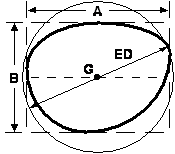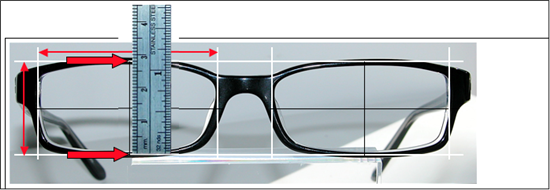Frames sizes are listed using a worldwide standard that ensures a systematic way to determine frame size. In fact, the sizes are actually the size of the lens opening and it's called the Boxing System. Why? Because a box is drawn around the lens where the vertical and horizontal lines of the box touch the farthest sides of the lenses whether they have a pointed bevel or are flat for rimless or grooved rimless lenses. It looks like this.

BOXING SYSTEM
A - EYE SIZE - The horizontal width between the two vertical lines tangent to the edges of a lens—or a box enclosing the lens. Be sure to consider the depth of the bevel when measuring the frame.
B – EYE HEIGHT - The vertical height between the two horizontal lines tangent
to the edges of the lens—or a box enclosing the lens. Be sure to consider the depth of the bevel when measuring the frame.
DBC - Distance between centers; the distance between the geometric centers of the right and left lens openings.
DBL – Bridge size; the minimum distance (nasal) between the two lenses or
frame openings.

ED – Effective Diameter; twice the longest radius from the geometric center of lens to the farthest edge; the smallest circle that will completely enclose the lens.
G - The geometric center of an imaginary box enclosing the edges of a finished lens or opening in a frame ( 1/2 B and 1/2 A measurements).
HOW TO MEASURE A FRAME
With a mm rule in hand, take a frame from the frame board. Hold the ruler over the frame front and sight an imaginary line from the farthest edge of a box touching the left temporal lens edge of the right eye to the right edge of the box. That's the A dimension.

Next, measure the DBL or "bridge" size.

Lastly, turn the ruler and measure the "B" or vertical size of the lens.

You can measure the longest diameter but it is not the Effective Diameter (ED) that your lab requests. The ED is 2x the longest radius and if you're interested, that's another page in the Handbook. A quick approximation is to add 2mm to the longest diameter of the opening. I know some lab folks that will throw tomatoes at me for suggesting that. Don't worry, if you are sending a frame to the lab for lenses, they will trace the frame and measure the effective diameter directly.










